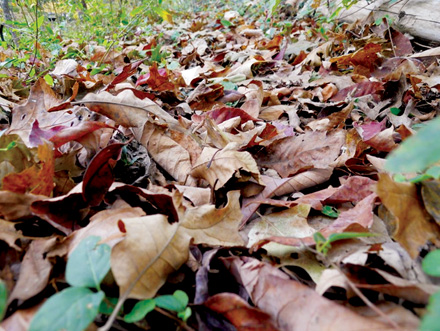Don’t bag those leaves

What if I told you there is something that will improve what soil you have, easily make new soil and take almost no work to do it?
Good, then stop bagging those leaves. I know some of us want to have immaculate lawns but you are doing your garden a huge disservice by removing those leaves and making extra work for yourself to boot.
According to the Farmer’s Almanac, leaves of one large tree can be worth as much as $50 worth of plant food and humus. They are a rich source of calcium, magnesium, phosphorus, potassium and trace minerals tree roots have mined from deep in the subsoil. Pound for pound, leaves contain twice the mineral content of manure.
Leaves are wonderful soil conditioners. Leaf humus can lighten heavy clay soils, which we have, and increase the moisture retention of dry sandy soils. For those of us who try to garden in the Ozarks and primarily grow rocks, leaves are an incredibly available source to easily improve our soils.
I don’t have much soil in my garden on the side of a limestone hill so l have been letting leaves compact and disintegrate for decades. Several years ago, I was curious if my new soil pH was somehow more alkaline than usual. With the help of a soil test through University of Missouri Extension, I can confirm my leaf-based soil is right smack dab in the middle, where it should be.
Leaves also make ready mulch. After our first hard frost, I literally kick piles of leaves into flowerbeds with my boots, sometimes dumping bags of leaves from a neighbor’s house. I used to rake leaves onto flowerbeds but now I have too many plants to safely rake without pulling them out. Frankly kicking them around is much more fun.
Now if I had a lawn mower, I would be tempted to mow over them a few times to speed decomposition. As it is, I pile them on flowerbeds and watch them disappear by spring so no need to go to the extra effort.
One thing you can do with leaves is compost. Rake them into piles or enclose them in bins, one of my gardening friends made some very nice compost bins out of recycled pallets. If you have been seduced by a leaf vacuum, many have a shredder that reduces the volume of leaves being inhaled. The broken down leaves also make a very nice mulch layer.
To compost, mix a shovelful of soil in each layer of leaves to introduce helpful microorganisms to the pile. Leaves are high in carbon but low in nitrogen. It helps to add a source of nitrogen like manure or grass clippings to help feed the bacteria that will be doing all the work of breaking down the leaves.
My youngest brother one year bagged leaves in black bags, then promptly forgot about them. When I visited a year later, the leaves had broken down into beautiful leaf compost we spread around his vegetable patch. Doesn’t get much easier than that
Charlotte Ekker Wiggins is a certified gardener, beekeeper and sometimes cook. Copyright 2016 used with permission, all rights reserved. This material may not be published, broadcast, rewritten or redistributed. Contact Charlotte at chargardens@gmail.com.

GTD COMPOSTERS – Both of these composters are easy to use and quickly turn leaves into rich, soil amendment to improve your garden beds. (Photos by Charlotte Ekker Wiggins).

GTD FREE FERTILIZER – Fall leaves are free treasure troves of beneficial soil amendments that are easy to incorporate into our gardens with very little effort.



Facebook Comments